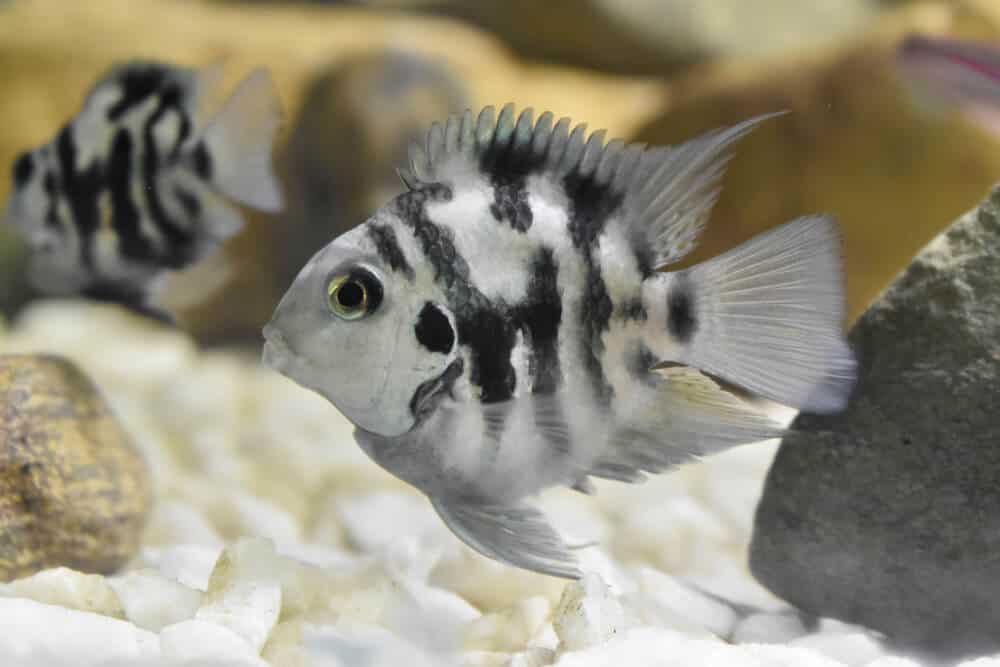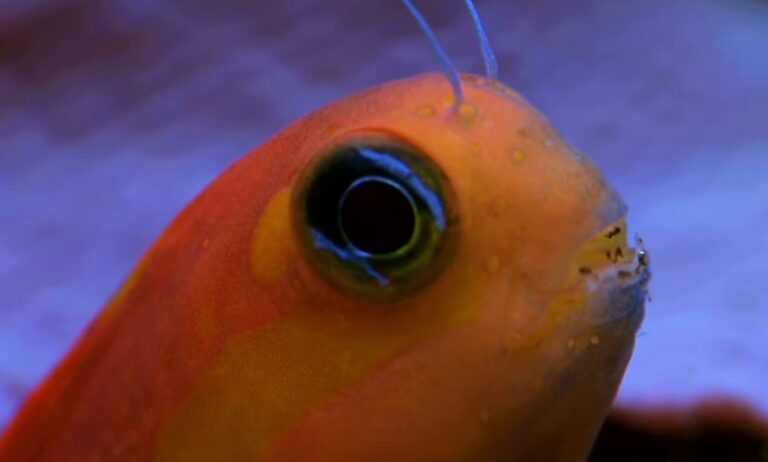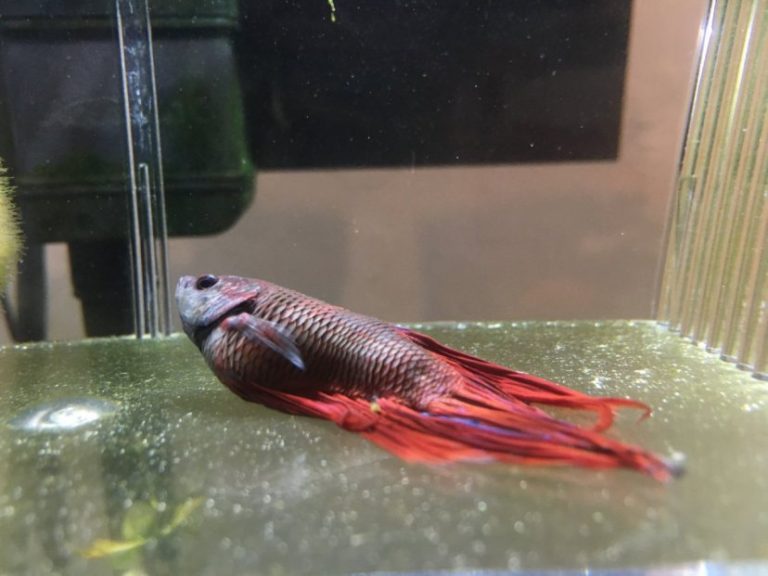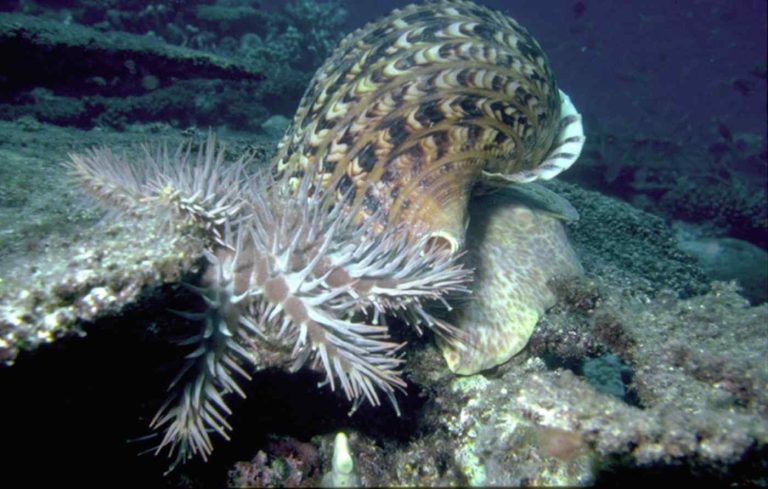The Ultimate Guide to Convict Cichlid Growth: How Big Do They Get?
Convict cichlids can grow up to six inches in length. These small-sized fish are native to central america, particularly in the nicaragua and honduras region.
Convict cichlids are popular among aquarium enthusiasts due to their colorful appearance, hardy nature, and easy breeding habits. They are known for their white and black stripes, which make them easy to identify. Convict cichlids are also very territorial fish, which means they should not be kept with smaller, less aggressive species.
In this article, we will learn more about convict cichlids, including their natural habitat, behavior, diet, and the best practices for keeping them in your aquarium.

Credit: badmanstropicalfish.com
Understanding Convict Cichlids
What Are Convict Cichlids?
Convict cichlids are fascinating freshwater fish that belong to the cichlidae family. Scientifically known as amatitlania nigrofasciata, they are also commonly referred to as zebra cichlids, convict fish or simply convicts. Here are some key points to help you better understand these colorful fish:
- Their name “convict” comes from their black and white striped patterns resembling the old-fashioned prison uniform.
- They are native to central america and are commonly found in rivers, lakes and streams in countries like guatemala, honduras and costa rica.
- Convict cichlids can grow up to 6 inches long, with females being slightly smaller than males.
- They are often kept as pets in home aquariums due to their hardiness and beautiful appearance.
Their Natural Habitat
Knowing the natural habitat of convict cichlids can help provide context for how to care for them properly. Based on their natural environment, here are some important things to consider:
- Convict cichlids are usually found in freshwater with a slightly alkaline ph level (7.0 to 8.0), and a temperature between 72°f and 82°f.
- Their natural habitat is filled with various types of aquatic plants, rocks, caves, and other structures that allow for hiding and breeding.
- Convict cichlids are omnivores, meaning they eat both plants and animals, so a well-balanced diet of both is crucial to their health.
Convict Cichlid Behavior
Understanding the behavior of convict cichlids can provide helpful insights into their care and behavior. Here are some important things to know about convict cichlid behavior:
- Convict cichlids are known for being relatively aggressive, territorial, and protective of their eggs and young.
- They are cave breeders, and the female usually finds a cave or digs one out as her territory for laying eggs.
- Convict cichlids can lay up to 600 eggs, and both parents take care of their offspring, which helps their young to grow rapidly and survive longer.
- Convict cichlids are social and should be kept with other species that can tolerate their aggression.
By understanding these key points about convict cichlids, you can enhance your appreciation for these fascinating creatures and provide the best care for them in your aquarium.
Factors Affecting Convict Cichlid Growth
Convict cichlids, also known as zebra cichlids, are freshwater fish. They are a popular aquarium fish species that are native to central america. Convict cichlids are known to be aggressive but captivating fish to watch due to their active and playful nature.
To keep these fish healthy, you need to ensure that they are in an ideal environment and receive a balanced diet. Let’s take a look at the factors affecting convict cichlid growth.
Water Quality And Temperature
Water quality and temperature are the most important factors affecting the health of convict cichlids. If your fish live in dirty water with low oxygen levels, they can develop all sorts of health problems. Here are some key points for maintaining their environment:
- Keep the water ph between 7.0 to 8.0.
- The ideal water temperature range for convict cichlids is between 72°f to 82°f.
- Changing the water on a regular basis, at least once in a month, to ensure the water is fresh and has a high oxygen level.
- Install a high-quality filtering system to keep the water clean and free from harmful chemicals.
- Add plants to their environment to provide them with shelter.
Feeding Habits
Convict cichlids are omnivorous, which means they eat both plants and animals. It’s essential to balance their diet and avoid overfeeding to maintain a healthy weight. Here are some key points on feeding your convict cichlids:
- Feed them twice a day, but in small portions to avoid overfeeding.
- Give them appropriate food such as pellets, flakes, spirulina and frozen brine shrimp.
- You can also feed them live food such as earthworms.
Tank Size And Space
Convict cichlids require enough space to thrive in a healthy environment. Lack of space may lead to aggression and slow growth. Here are some tips to ensure they have enough space:
- A minimum tank capacity of 30 gallons for a fully grown pair of fish.
- Provide adequate hiding spaces using driftwood, plants, and rocks.
- Keep the number of fish in the tank to a maximum of four or five.
Other Environmental Factors
There are other environmental factors that can affect the growth of convict cichlids, including the lighting, substrate, and water flow. Here are some important tips to ensure a suitable environment:
- Provide them with moderate lighting, primarily if the tank is near natural light.
- Use fine substrate like sand instead of gravel to protect their barbels.
- Ensure a moderate and gentle water flow within their tank.
The factors mentioned above play a vital role in ensuring a healthy environment for your convict cichlids. You should regularly monitor and maintain their aquarium to help these beautiful fish thrive and reach their full potential.
Growth Timeline Of Convict Cichlids
Convict cichlids are fascinating fish to keep in an aquarium, and their growth pattern can be a matter of interest for aquarists. If you’re considering adding these fish to your aquarium or have already added them, but want to know more about their growth timeline, this post is for you.
We’ll cover the growth timeline of the convict cichlids, the average growth rate, and how to measure the growth of these fish.
Stages Of Growth From Fry To Adult
Convict cichlids are hardy and robust fish species, and they are also prolific breeders. The growth of convict cichlids can be divided into various stages:
- Fry: Newly hatched convict cichlids are called fry and are extremely tiny. They are usually less than an inch in size at this stage.
- Juvenile: After about a month, the convict cichlids reach juvenile stage. At this stage, they are still small but can grow rapidly in the right conditions.
- Subadult: After about six months, the convict cichlids reach the subadult stage. At this phase, they have almost achieved their full-grown size but lack the bright colors of the adult convict cichlid.
- Adult: When the fish reaches around a year old, they will develop into adult fish with vibrant stripes and colors.
Average Growth Rate Of Convict Cichlids
The growth rate of a convict cichlid depends on several factors such as gender, feeding schedule, temperature, and the size of the aquarium. However, on average, these fish will grow to the following sizes:
- Fry: 0.5 to 1 inch
- Juvenile: 1 to 2 inches
- Subadult: 2 to 3 inches
- Adult: 4 to 5 inches
How To Measure The Growth Of Convict Cichlids
Here are some ways to measure the growth of the convict cichlid:
- Measure their length using a ruler or a measuring tape. Make sure to measure from the tip of their snout until the end of their tail fin (caudal fin).
- Keep a growth chart, or a spreadsheet to track their growth progress. This way, you can monitor their growth rate, and identify unusual patterns.
- Weigh them using a digital scale. This is less common compared to measuring length; however, it can still provide an accurate way to track the growth of convict cichlids.
The growth timeline of the convict cichlid is divided into fry, juvenile, subadult, and adult stages. The average growth rate and size of these fish depend on various factors such as gender, feeding schedule, temperature, and aquarium size. By measuring their length or weight, keeping regular growth charts, or monitoring their growth progress, you can ensure the health and well-being of your convict cichlids.
Maximum Size That Convict Cichlids Can Reach
Convict cichlids are a popular choice among aquarium enthusiasts. They are known to be hardy, adaptable, and have vibrant colors. One of the most commonly asked questions about these fish is, “how big do convict cichlids get? ” We will explore the maximum size that convict cichlids can reach, as well as the factors that contribute to their size.
Average Size Of Convict Cichlids
Convict cichlids are relatively small fish that can fit in most home aquariums. On average, they grow to be around 4-5 inches long. However, the size of the fish can vary depending on a variety of factors such as diet, genetics, and water conditions.
Here are some key points to keep in mind about their average size:
- Male convict cichlids tend to be larger than females.
- The size of the fish can also be affected by the size of the aquarium they are kept in.
- Proper diet and water conditions can help them reach their maximum size potential.
Examples Of Convict Cichlids That Have Grown To Impressive Sizes
While convict cichlids may be small, there have been cases where they have grown to impressive sizes. Here are a few examples:
- The largest recorded convict cichlid was over 12 inches long and weighed almost 2 pounds!
- Some aquarium enthusiasts have reported growing convict cichlids up to 8-10 inches long.
While these instances are rare, they do highlight the potential size that these fish can reach with proper care and conditions.
What Factors Contribute To Their Maximum Size
There are several factors that contribute to the maximum size that a convict cichlid can reach. Here are a few key points:
- Genetics: Like all living things, a convict cichlid’s genetics play a significant role in determining their potential maximum size.
- Diet: A well-balanced diet that includes protein-rich foods can help convict cichlids reach their full size potential.
- Water conditions: Water quality and conditions such as temperature can also affect the size and growth rate of convict cichlids.
- Tank size: Providing adequate tank space is essential for any fish to grow to their maximum size.
The maximum size that a convict cichlid can reach will vary depending on the factors mentioned above. As long as they are provided with adequate care and conditions, they can grow to be impressive fish that will brighten up any aquarium.
Best Practices For Promoting Convict Cichlid Growth
Convict cichlids, also known as zebra cichlids, are a popular species in the aquarium hobby due to their hardy nature and striking appearance. Like all fish, proper care and attention can help them grow to their full potential. In this section, we will discuss the best practices for promoting convict cichlid growth.
Ideal Diet For Convict Cichlids At Different Growth Stages
A well-balanced diet is essential for convict cichlid growth! Their diet should consist of both meaty and vegetable-based foods. Here are some guidelines on what to feed your convict cichlid based on their growth stage:
- Juvenile convict cichlids: Feed them a protein-rich diet of brine shrimp, bloodworms, daphnia, and high-quality cichlid pellets.
- Adolescent convict cichlids: Introduce vegetable-based foods such as spirulina, algae wafers, and blanched vegetables to their diet in addition to their protein-rich foods.
- Adult convict cichlids: As adults, their diet should consist of a mix of high-quality cichlid pellets, live or frozen foods such as brine shrimp, bloodworms, and krill, and blanched vegetables.
Maintaining Stable Water Quality And Temperature
Convict cichlids inhabit warm-water streams and rivers in the wild, so it’s essential to maintain a stable temperature in their aquarium. The ideal water temperature for them is between 75°f and 80°f. Keeping the water parameters stable is also crucial for their growth.
Here are some tips to help maintain water stability:
- Regular water changes: Change 10-20% of the water weekly to prevent a buildup of harmful compounds such as ammonia and nitrite.
- Use a water conditioner: Use a water conditioner to remove chlorine and chloramine from tap water before adding it to the aquarium.
- Check the ph: Maintain a ph level between 7.0 and 8.0. Use a ph test kit to check the ph level regularly.
Creating An Optimal Environment For Convict Cichlid Growth
Providing an optimal environment for convict cichlid growth means creating an aquarium that mimics their natural habitat. Here are some tips to create an ideal environment for them:
- Provide hiding places: Convict cichlids are territorial and need hiding places to feel secure. Use caves, rocks, and driftwood to provide hiding places.
- Use substrate: Use a fine-grained substrate such as sand or gravel to mimic their natural habitat.
- Add plants: Adding live plants helps to create a natural environment and aid in maintaining water quality.
Common Mistakes To Avoid In Promoting Growth
While it’s essential to provide a proper diet, maintain stable water quality, and create an optimal environment to promote convict cichlid growth, there are also some common mistakes to avoid. Here are some things to avoid:
- Overfeeding: Overfeeding can lead to health problems such as bloating and a short lifespan.
- Adding incompatible fish: Avoid adding fish that are too aggressive or too small and can become food for the convict cichlid.
- Overcrowding: Overcrowding can lead to territorial aggression, stress, and disease.
Following these best practices will promote the growth and health of your convict cichlids, allowing them to thrive in their aquarium.
Frequently Asked Questions On How Big Do Convict Cichlids Get
How Big Can A Convict Cichlid Grow?
Convict cichlids can grow up to 6 inches in length, with males being larger than females.
How Fast Do Convict Cichlids Grow?
Convict cichlids grow at a moderate rate, reaching their full size in about a year.
How Long Do Convict Cichlids Live?
With proper care, convict cichlids can live up to 8 years in captivity.
How Many Convict Cichlids Can Be Kept In A Tank?
It is recommended to keep one pair of convict cichlids in a tank, as they are territorial and can become aggressive towards each other or other fish.
Conclusion
Convict cichlids can grow up to six inches in length and are known for their aggressive behavior. These territorial fish require a spacious tank with plenty of hiding spots and a balanced diet to thrive. It’s important to monitor the water temperature and quality, as well as the compatibility of other fish in the tank.
As pets, convict cichlids can make fascinating additions to your aquarium and with proper care, they can live up to ten years. Understanding the growth potential, behavior, and care requirements of these fish will help you create a healthy and vibrant aquatic environment for them to flourish in.
With proper research and preparation, you can enjoy the beauty and splendor of these fascinating creatures while providing them with the care and attention they deserve.






